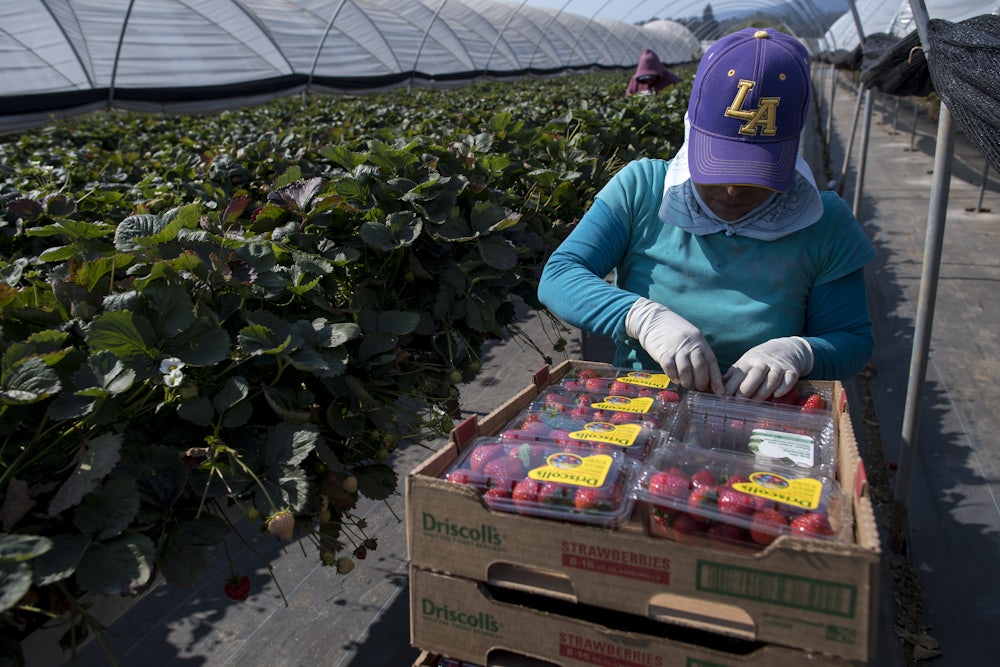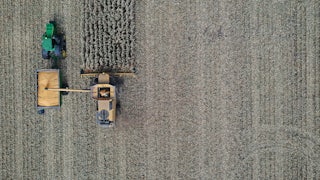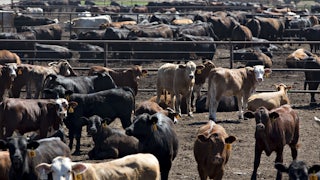To understand Driscoll’s, it’s helpful to think of the berry giant less as a farm business than as a genetics and marketing company. Driscoll’s owns the patents to a given berry’s genetics, which it licenses to approved growers on an exclusive basis. The company then markets these berries under the Driscoll’s brand.
This involvement with genetics is deeply embedded in the company’s DNA. In the early 1900s, Joseph “Ed” Reiter teamed up with his brother-in-law, Richard Driscoll, to develop and market a variety called the Banner. The berry stood out from the crowd. But at that time, there was no way to patent a plant’s genetics, which meant that anyone could cultivate the variety, so Reiter and Driscoll had competition.
This hurdle was removed when President Herbert Hoover signed the Plant Patent Act of 1930, which enabled Reiter and Driscoll to claim ownership of breeds they engineered. The Banner variety was ultimately hit hard by disease—a common issue with monocultures—but the business model had been proven.
Driscoll’s isn’t alone in exploring advances in strawberry genetics. The University of California system has long run a strawberry-breeding program to boost the industry. As Dana Goodyear described in The New Yorker, the operation “is Driscoll’s antithesis—public, open, nonexclusive—supplying, for a nominal royalty fee, any grower wishing to use its plants.”
The program ran into problems in the middle of the twentieth century. Most of the strawberry growers in California at the time were Japanese, and when over 120,000 Japanese Americans were imprisoned during World War II, there was suddenly a severe shortage of growers. The disruption likely hurt the lab’s finances. In the Reiters’ telling, the problems were so serious that the strawberry lab at UC Berkeley was making plans to abandon its work, though ultimately it never did.
It was in this void that the Reiters sowed the seeds of their fortune. Two key researchers quit the university program and went to work for the family. With these hires, the Reiters grabbed the knowledge and skills that had previously been directed toward building intellectual property available to the public and instead put them to work producing privately owned varieties of strawberries.
Driscoll’s was established in 1950 when Ed’s son, Joe Reiter, joined forces with a few other berry growers. Not long after, some wily genetic maneuvering produced a patentable strawberry that could be shipped to the East Coast, which was the holy grail of strawberry breeding. The variety also fruited later than its competitors, giving it a seasonal advantage that creates a temporary and lucrative monopoly. That’s one reason why California currently grows 90 percent of domestically produced strawberries. Before the variety was patented, the state ranked only eighth nationally in terms of acreage used in strawberry production. In fact, Arkansas once had three times the acreage of California.
Driscoll’s focus on genetics resembles the business model described by Naomi Klein in her book No Logo: Taking Aim at the Brand Bullies. Klein deconstructed the rise of the brand and the logo, with a particular focus on the example of Nike, a multibillion-dollar company that doesn’t actually manufacture anything. Instead, it pays to put its logo—the infamous “swoosh”—on clothing that other companies make.
Nike’s competitive advantage is not in its products but in its brand. Nike spends most of its time and energy putting together ad campaigns featuring the swoosh. A generic gray shirt might sell for $10, but the same shirt made in the same factory with a swoosh printed on it sells for three times more. The price difference reflects customers’ willingness to pay a premium for a piece of clothing to associate themselves with the image created by Nike’s ad campaign.
The Driscoll’s business model is in many ways akin to those of Nike and some of its neighbors in Silicon Valley. Its niche isn’t to grow the strawberries but to breed, brand, and transport them and rake in profits from everyone else’s sweat. A senior vice president at Driscoll’s summed up this philosophy, pointing out that “[berry] growers are sort of like our manufacturing plants. We make the inventions, they assemble it, and then we market it, so it’s not that dissimilar from Apple using someone else to do the manufacturing but they’ve made the invention and marketed the end product.”
Although Driscoll’s does not farm the berries it sells, it maintains control over the fruit throughout the process. Driscoll’s likely dictates how the fruit is grown and, of course, sets the price it will pay to the farmers. This model of production has deep roots in American agriculture. Professor Douglas H. Constance refers to it as the “Southern Model,” emerging in chicken production in the South in the 1940s. Under this model, a corporation controls almost every aspect of the production chain. In the case of chicken, the corporation owns the breeding, hatching, feed mills, transportation, and processing plants, meaning that it does everything but raise the bird, which it usually contracts out because it is the riskiest part of the production process. The farmer, meanwhile, is required to use the corporation’s hatchling and feed and then sell the bird back to it. “Contract [chicken] production is but a formalized form of sharecropping,” Constance writes—“a remnant of slavery in the U.S. South.”
The Southern Model quickly spread across the food industry and around the world, with nuances specific to crop and locale. The relationship between Driscoll’s and its approved suppliers is not necessarily as exploitive as the one between chicken farmers and companies like Tyson’s. After all, Garland Reiter is the chief executive officer of an entirely separate company that grows berries for Driscoll’s as an approved supplier. Yet ultimately, by owning its brand and the genetics of the berries, Driscoll’s maintains control over the entire production chain even as it disclaims responsibility for growing the berries.
These days, Driscoll’s employs about 30 people at nine locations across the globe to do this breeding. The company refers to these scientists as “Joy Makers,” referring to the ecstasy of biting into a delicious, perfectly engineered berry. J. Miles bragged in a company promotional video that “it is unusual in our industry to commit as much as we do to R&D, but it was really the basis for founding Driscoll’s.”
Driscoll’s headquarters sits at the end of a cul-de-sac in a generic building in an office park in Watsonville, California, right next to Highway 1, the iconic coastal highway. There are no tours or company store or even a berry statue. You would never guess that a berry empire is run out of this nondescript slab of concrete but for the Driscoll’s sign out front. But once you start poking around, you begin to see the tendrils of the empire snaking out: The California Strawberry Commission is located just up the road, in the same office park as Driscoll’s. California strawberry growers founded the organization in 1955 to try to get more people to eat strawberries.
Surrounded by berry fields about 15 miles east of Santa Cruz, Watsonville is nestled in the heart of the Pajaro Valley, a key center for agricultural production in the state. Even aside from Driscoll’s suppliers, many of the valley’s large employers have some connection to farming. Watsonville’s population of about 50,000 is mostly working-class Latino.
Watsonville is in one of the two big strawberry-producing regions in America. The other is farther south, near the cities of Oxnard and Santa Maria, just north of Los Angeles. Berries love this coastal climate, which simulates a perpetual spring, so they end up producing strawberries for much longer than the berries in my grandpa’s Iowa backyard, which fruit for only a short time.
But while the temperature may be perfect for strawberry production, the rainfall isn’t. In fact, Watsonville gets only about an inch of rain between May and September. That’s a problem for water-intensive crops such as strawberries. After all, 91 percent of a strawberry is water.
Because Driscoll’s suppliers aren’t getting their water from the sky, they’re largely pumping it from underground. Roughly 90 percent of the water supply in the Pajaro Valley comes from groundwater. Driscoll’s acknowledges that most of the fields in which the company’s fruit is grown are irrigated with groundwater.
Those wells have contributed to the aquifers becoming severely overdrafted—more water flows out than in—and to salt water being drawn in from the ocean. That’s a problem for the farmworkers and other residents who rely on wells for drinking water, particularly when drilling new, deeper wells in California can run to $55,000, according to The Washington Post. It’s also bad for the farms themselves; some farmers in the Pajaro Valley have found that the groundwater is too salty to use for irrigation.
In early September 2022, farmworkers and other residents of the Pajaro Valley held a press conference on a 30-foot-wide dirt road that separated berry fields from an elementary school. Parents and children held a printed banner pleading, “Stop Poisoning Our Kids: Go Organic!” The group called on berry growers to stop spraying traditional, nonorganic pesticides near schools and residential areas, which they believed were responsible for neurological and other diseases affecting local children. They didn’t seem to buy the industry-funded studies that claimed the chemicals were perfectly safe.
A few months later, J. Miles Reiter and other Driscoll’s employees met with the activists. Reiter acknowledged that over time, going organic was a worthwhile goal. But the company made no commitment to require its growers located near schools, parks, and hospitals to do so. Reiter had earlier argued that it was up to the growers, not Driscoll’s, to decide whether to go organic.
Once again, being the seller of berries, rather than the grower, proved useful. Yet Driscoll’s has set up a system that makes these chemicals if not necessary, certainly expedient. It all comes back to producing as many identical berries as cheaply as possible.
To understand why fumigants are particularly attractive to Driscoll’s suppliers, and strawberry growers in general, it helps to know a little about the plant itself. If you’ve ever grown strawberries in your backyard, you might have noticed that the plants sprout horizontal stems that run above the ground and generate new plants at varying intervals. The main plant is known as the “mother,” and the horizontal stems bolting above the ground are known as “runners.” The runners are effectively clones of the mother plant.
I used to help my grandpa with his strawberry patch behind his house in Iowa. He would till every other row so that the runners could fill in that space. It’s a common practice with strawberries because younger plants tend to produce more berries, which of course is the goal for a global supplier such as Driscoll’s.
Strawberries are fickle and research-intensive to breed. Like hybrid corn seeds, strawberry seeds don’t yield the same plant they came from but instead produce a slightly different variety. But runners allow breeders like Driscoll’s to plant exactly the same berry they patented.
The downside of planting clones is that they create the potential for disease to spread rapidly because of their genetic similarities. To prevent crop loss, berry farmers fumigate their land before planting the runners. If you’ve ever driven near strawberry fields, you might notice rows of black plastic mounds. The mounds make it easier for pickers to collect the berries, and the dirt is enclosed in plastic to capture the fumigation gases injected into the soil. This process kills not just the diseases farmers worry about but everything else in the soil too, as a report on All Things Considered noted in 2012.
Organic strawberry fields are typically not subjected to these chemicals. Instead, an organic farmer might grow berries in a different field each year, returning to the original plot only after several years to make sure remnants of diseases don’t remain in the soil. Driscoll’s does control about 60 percent of the U.S. market for organic strawberries, but this is likely a small portion of its total business. After all, the fumigation approach requires less land, which is key when you’re supplying a global market. For most of Driscoll’s suppliers, fumigants are just part and parcel of farming.
Methyl bromide was widely used as a fumigant dating back to the 1960s. Sociologist Julie Guthman, who wrote a book on the subject, believes that this highly effective odorless, colorless gas fueled the strawberry industry’s growth. But then scientists discovered that it damages the earth’s ozone layer. Despite years of industry resistance, this finding led to restrictions on the use of methyl bromide for strawberries grown outside nurseries.
Methyl bromide has largely been banned, but other fumigants have taken its place. The use of these gases has stirred protest not just in the Pajaro Valley but across California, where berry fields often abut schools, parks, and hospitals. For context, one district in the state has 18 schools located directly adjacent to farmland. That’s significant because some studies have linked fumigants to lower IQs in kids, along with other health problems.
Eventually, the chemicals can make their way into nearby waterways. The U.S. Environmental Protection Agency has classified most of the canals that surround Driscoll’s and the California Strawberry Commission as impaired, largely because of the presence of bacteria and toxic chemicals.
For the most part, farmworkers and their families have dealt with the brunt of this pollution. J. Miles and Garland Reiter certainly don’t live near the berry fields; they own coastal estates in Santa Barbara and Santa Cruz. In fact, a lot of “farmers” in California don’t live on farms. The largest farmer in California lives in Beverly Hills and controls almost enough farmland to cover the five boroughs of New York City.
Increasingly, farm owners aren’t even individuals or families but are corporations and other institutions. Harvard University bought thousands of acres of California farmland as part of its investment of its massive endowment. The arrival of Wall Street money has only intensified inequality in an already unequal area.
The food system is dynamic and always shifting. But when corporations such as Driscoll’s run the show, it shifts in whatever direction allows them to accrue maximum profits. That’s the current trajectory of American agriculture. Wall Street and large corporations such as Driscoll’s have taken control of the agricultural sector, while the communities they operate in and the workers who pick their berries are left holding the bag.
This article is an adapted excerpt from Barons: Money, Power, and the Corruption of America’s Food Industry.








